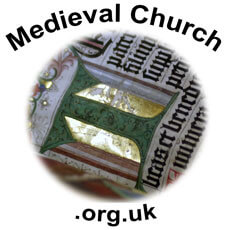Saint Boniface
Ken Garnett
Theology on the Web helps over 2.5 million people every year to find high quality theological resources that will help to equip them to serve God and to know Him better (2 Timothy 2:15). Like other websites that provide free services, it is dependent on donations to enable it to grow and develop and only 0.004% of visitors currently do so. If you would like to support this site, please use one of the options to the right of this message.
Boniface of Crediton was born about 672-675 of noble parents. His Saxon name was Wynfrith, a compilation of his parent's names - "wyn meaning pleasure or joy, frith peace"(1) He led a life of a monk, priest and missionary and was to die a martyr's death on the mission field at Dokkum in Frisia on June 5th 754. Called by some "the apostle of Germany" and the "Greatest Englishman"(2) by others, he is of immense historical significance and has been credited with the title "the founder of the West"(3).
His personal attributes were those of a great leader, reformer and organiser whose work confirmed and established the Church in the West at a time when it was suffering serious attacks by Islam. He is reckoned to have been a man of irreproachable conduct and consistent Christian testimony. His ministry sparked two unforeseen developments: i) a rebirth of the Roman Empire in Christian dress in Northern Europe - the Holy Roman Empire of the German nation, and ii) a reorientation of the Papacy from the East to the lands of the West which became France and Germany.
At an early age he entered a monastic order at Exeter (Adesrancastre), but this was a small foundation, lacking in library facilities and so he moved to Neersling (Nhutscelle) under Abbot Winbert(4). Here he studied hard and well, becoming head of the school, attracting outside monks and nuns as pupils. Such was his scholarship that he compiled a Latin grammar. The Monastic Ideal had a strong formative influence on him and would play a significant role in his missionary work. At the age of thirty he was ordained Priest and eventually had a role in the Saxon synods of the early 8th century.
At the age of about 46 in the year 716 he took a step that changed the course of his life. Following in the footsteps of the missionary Willibrord (and others) he went to Frisia on the continent. At this time the churches planted by Willibrord were being destroyed and attacked by Radbod, who was leading a revolt against Frankish rulers. In these circumstances it is of no surprise that Boniface did not succeed and he returned to England. To his credit he did not lose his missionary vision and even declined his election as Abbot to follow his calling. In 718 he returned to Europe and, after receiving the backing of 'Pepin' the mayor of the palace (the real power over the Franks under the Merovingian dynasty) he proceeded to Rome. Here, on May 15, 719 he was made missionary to Germany by Pope Gregory II and was now called Boniface. His commission was on the understanding that he used the Roman formula for baptism and consult Rome about any problems. His goals from this point on was the conversion of pagans and the reformation of corrupt Churches and Christianity as he saw it.
His Methods
Boniface learned from his early failure well, he had gone in the first instance to Frisia in the time-honoured manner of the Celtic missionaries, i.e. with little or no planning, no organisation and little or no consolidation. A common happening which became at offence to him was the Celtic predilection to abandon converts at a whim and the falsification of credentials. These he avoided and developed a strong policy of organising the Church toward dioceses and provinces under the Pope. Along with this he established centres of learning in abbeys and monasteries, the most famous perhaps being the abbey at Fulda which became a centre of Roman Catholicism. These trained bishops and teachers who would eventually permeate society with their ethics and learning. Besides establishing stable centres of Christianity in an uncertain pagan world another very important aspect in his methodology was his continuing links with the Church in England. He was a man of wide correspondence and he used and maintained his contacts for prayer support, personnel, and all sorts of material. Through his efforts many people went from England to staff, establish, organise and maintain the Churches and centres he planted. In his use of personnel he valued and used the fair sex and had warm and sincere fellowship with them. The 'rules' of the monasteries of his time were usually a mixture of whatever was thought best, it was the age of the 'regula mixta'. He orientated the monasteries wherever he could to the Benedictine rule which was the best of his day, and did much to influence society by its ethic.
With regard to evangelism he is famous for his confrontation with Paganism at the Donar Oak tree at Geismar in Hesse. Here he made a violent frontal assault in chopping it down - although tradition states that it fell over after a few blows. When the pagan god did not reply to this effrontery the locals were duly impressed. But two contributing factors besides his faith need to be remembered: i) pagan fear of tree felling had been under pressure for some time through the clearing of virgin land granted to the churches by local rulers. ii) The protection of the ruler of the Franks, Charles Martel. Here fear of reprisal by the sword played its part. Boniface would later be advised to moderate violent confrontation in evangelism by Binhop Daniel, who advocated the power of reason and debate.
The role of political protection and sponsorship was crucial to Boniface. At this time the Church and the State served each other's needs. The christianisation of the pagan tribes on their borders could only benefit the Frankish rulers. The mayors of the Merovingian dynasty stemmed themselves "from St. Arnulf, Bishop of Mety"(5) This link would culminate in the coronation by the of Charlemagne by the Pope on Christmas day of 800 as Holy Roman Emperor.
In conclusion Boniface was not only a successful evangelist and converter of a vast number of people but he also succeeded in reforming the Church where he found it lacking through synods. Where there was no strong organisation he gave it one, all with a common orientation to Rome. He was able to evaluate his early failure positively, which opened his eyes to the need of sound organisation and planning under the protective umbrella and authority of Church and State. Maintaining strong links with the Church in England provided him with a wide base of prayer support, as evidenced by his letters and a steady supply of personnel and material to staff the churches and centres he planted. Completing his work as Papal delegate he returned to missionary work carrying with him his burial shroud - this surely shows his genuine missionary attitude of heart - he paid the ultimate price.
Ken Garnett
References
(1) T. Reuter, ed. The Greatest Englishman. Essays on St. Boniface & the Church at Crediton. Exeter: Paternoster Press, 1980. P.21.
(2) See n.1. - the title of the book.
(3) J.D. Woodbridge, Great Leaders of the Christian Church. (Chicago: Moody Press, 1986) 120.
(4) Reuter, 56. This was not normal, one of the rules would be one of stability, i.e. a vow to remain with the house until death there being two exceptions: i) going to be an hermit; ii) pilgrimage to Rome.
(5) R.G. Parsons, & A.S. Peake, eds. An Outline of Christianity. The Story of Our Civilisation, Vol. 2. London: Waverley Book Club. p.163.
Bibliography
Caxton's History of the World. The Age of Feudalism. London: New Caxton Library Service, 1969.
J.N. Clapham, ed. The Cambridge Economic History of Europe, The Agrarian Life of the Middle Ages. Cambridge: CUP, 1966.
G.J. Cuming, ed. The Mission of the Church and the Propagation of the Faith. Cambridge: CUP, 1970.
G.S.P. Freeman-Grenville, Chronology of World History. London: Rex Collings, 1978.
Hugh D. Farmer, The Oxford Dictionary of Saints. Oxford: Clarendon Press, 1978.
J. Foster, They Converted Our Ancestors. London: SCM, 1965.
W. Hunt, The English Church, From Its Foundation To The Norman Conquest (597-1066). London: Macmillan & Co. Ltd., 1899.
H. Mayr-Harting, The Coming of Christianity to Anglo-Saxon England. London: Book Club Associates, 1977.
J. McManners, The Oxford Illustrated History of Christianity. Oxford: OUP, 1990.
The New Encyclopedia Britannica, Micropedia, 15th edn. Chicago, Encyclopedia Britannica Inc., 1987.
R.G. Parsons, & A.S. Peake, eds. An Outline of Christianity. The Story of Our Civilisation, Vol.2. London: Waverley Book Club.
T. Reuter, ed. The Greatest Englishman. Essays on St. Boniface & the Church at Crediton. : Paternoster Press, 1980.
Charles Rundle, Martyrs & Saints of the First Twelve Centuries. New York: SPCK, 1923.
P. Schaff, History of the Christian Church, Vol.4. Grand Rapids: Eerdmans, 1987:92-100.
F. Stenton, Anglo-Saxon England. Oxford: Clarendon Press, 1975.
J.D. Woodbridge, Great Leaders of the Christian Church. Chicago: Moody Press, 1986.
H.B. Workman, The Evolution of the Monastic Ideal. London: Epworth Press, 1927.









